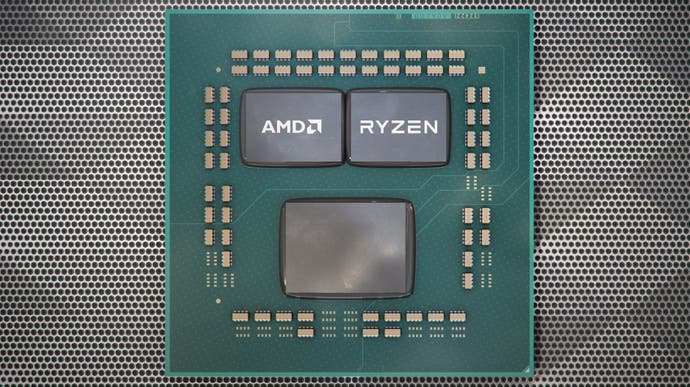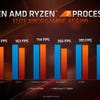AMD pitches its new wave of Ryzen 3000 CPUs to gamers
All the multi-core advantages of prior Ryzens, but with gaming power comparable to Intel's best.
AMD is bullish on the prospects of its Ryzen 3000 line of products coming early next month, telling press and analysts that the firm expects to maintain and extend its lead in productivity workloads while delivering IPC and single-core speed advantages that it says will nullify Intel's historical lead in gaming performance. On top of the stack of CPUs revealed last month at the Computex trade show, AMD has also debuted the existence of a 16-core, 32-thread monster processor - a first for the consumer space.
AMD finds itself in a good position right now. Both its CPU and GPU products use the state of the art 7nm fabrication process, which proves to be of crucial importance against Intel in the processor space. 'Chipzilla' has had significant issues in transitioning away from 14nm fabrication technology - its recent products have still been excellent (particularly for gaming) but the firm is hitting the limits of the process. As good as the 9900K was, it's a bit of a glutton when it comes to energy efficiency. Meanwhile, for AMD, 7nm allows it to close up the frequency deficit of prior Zen products, while IPC (instructions per clock) enhancements could potentially make all of the difference in addressing Ryzen's historical deficit in gaming.
Ryzen 3000 isn't just a shrink to the new 7nm process. The firm has moved to a new 'chiplet' design whereby multiple dies are integrated into the same product, allowing AMD more flexibility in addressing different markets. A single chiplet typically hosts eight cores with SMT (aka hyperthreading) while IO is handled via a separate die within the same package. The 12-core and 16-core products simply add another processor chiplet to the product (the former disabling two cores per chiplet). The IO die itself can also be swapped out, opening the door to different connectivity options for, say, the server market.
But it's within the chiplet where a lot of the innovation has taken place, and where AMD attempts to address gaming performance most comprehensively. Historically, memory latency has caused issues in some titles and there's the sense of an almost brute force solution in tackling this. Ryzen's already large L3 cache is effectively doubled in size, meaning that the new Ryzen 7 octo-core offerings get 36MB of cache, which almost doubles again to 70MB with the Ryzen 9 12-core chip. AMD reckons that introducing this vast cache on its own will see improvements of between five to 21 per cent in gaming performance, depending on the title. Indeed, so confident is AMD about this that the L3 cache is now known as 'GameCache'.

| Cores/Threads | Base/Boost Clock | TDP | Price | |
|---|---|---|---|---|
| Ryzen 5 3600 | 6C/12T | 3.6GHz/4.2GHz | 65W | $199 |
| Ryzen 5 3600X | 6C/12T | 3.8GHz/4.4GHz | 95W | $249 |
| Ryzen 7 3700X | 8C/16T | 3.6GHz/4.4GHz | 65W | $329 |
| Ryzen 7 3800X | 8C/16T | 3.9GHz/4.5GHz | 105W | $399 |
| Ryzen 9 3900X | 12C/24T | 3.8GHz/4.6GHz | 105W | $499 |
The 7nm process has allowed AMD to increase clocks which further adds to single-thread performance, but most of the improvements come from redesigning areas of the Ryzen silicon. The branch predictor is revamped, there's a larger micro-op cache and revamps to the integer units. Outside of raw IPC, there's also a doubling in floating point performance, which should help to address content creators' issues with some of the original Zen's shortcomings.
There are also improvements in the software side, which should benefit all Ryzen users - not just with the new processors. AMD has continued to work with developers in optimising code for its architecture, while at the same time collaborating with Microsoft in improving its task scheduler in the new May 2019 update to Windows 10. The OS will now attempt to cluster threads together within the same Ryzen CCX, cutting down on the latency incurred by spreading workloads across multiple CCXs. This should produce a more responsive system and AMD says that games should also benefit.
It's important to stress that Ryzen 3000 will work on existing AM4 motherboards, with AMD promising no impact to performance, but those looking to spec up a new system may be tempted by the new X570 chipset. The big advantage here is the introduction of PCI Express 4.0 support. While the implications for gaming may be limited, the arrival of compatible storage devices could be a big deal for those of us working in, say, video production on expansive 4K or even 8K projects. AMD seems to be blurring the lines between consumer level functionality and high-end desktop, which puts further pressure on Intel.
Where Intel has held an unassailable lead has been in gaming - an area AMD is clearly looking at muscling into. We devised a punishing workout for CPU game testing in our Core i9 9900K review, which showed AMD's prior flagship - the Ryzen 7 2700X - flagging compared to both 8700K and 9900K, falling short at both 1080p and 1440p, with a small deficit even at 4K. AMD isn't claiming outright performance leadership with Ryzen 3000 - simply that any difference doesn't really matter when its products offer more cores or threads and usually at lower prices. AMD has provided benchmarks, but as with any vendor supplied numbers, they should be treated with caution. Here are AMD's figures, followed up by a secondary table I put together.
| Ryzen 9 3900X ($499) | Ryzen 7 3800X ($399) | Ryzen 5 3600X ($249) | |
|---|---|---|---|
| Call of Duty BLOPs 3 | 206 | 206 | 206 |
| Devil May Cry 5 | 241 | 241 | 236 |
| GTA5 | 176 | 163 | 163 |
| Civilisation 6 | 114 | 114 | 114 |
| Overwatch | 282 | 266 | 259 |
| CS:GO | 429 | 391 | 360 |
| PUBG | 205 | 204 | 188 |
| Rocket League | 248 | 248 | 245 |
I've tabulated the multiple AMD results into one table above and one thing that springs to mind is how little variance there is between processors in many games, even as we traverse the big steps in the Ryzen product hierarchy and drop from a $499 processor to one that's half the price but still retains the vast majority of performance. There are two potential explanations here - either scaling across multiple cores doesn't increase performance that much (which is plausible) or else the results are skewed by GPU limitations. Perhaps I missed the appropriate data within the voluminous end notes on the presentations, but it's not actually clear which GPU is being used for these CPU tests. Regardless, such is the razor-sharp focus of AMD's marketing here that should it fall short significantly of the claims made, it may take off some of the sheen from what is otherwise an impressive line-up.
And included in that line-up is a product that AMD is especially keen to 'big up' as something of a love letter to the enthusiast. While the new Ryzen 5 sees six cores and 12 threads dip beneath a $200 launch price for the first time, it's the Ryzen 7 3700X that looks fascinating. It's a fully enabled eight-core, 16-thread part, but clocked lower with an impressively frugal 65W TDP. It also ships with AMD's top-end RGB Wraith Prism cooler, good for dissipating 125W - so the suggestion from AMD here is to really go to town on overclocking it. Priced at $330 ($70 cheaper than the 3800X), it could be a winner.
Having attended AMD's tech day, it's difficult to avoid the excitement and optimism around this product line-up, bolstered considerably by the possibility that Intel's production issues may make it significantly more challenging for them to respond short of delivering big price drops. But even with the arrival of more cores and more value from AMD, Intel has continued to 'own' the gaming space - and it's here where Team Red is now concentrating its efforts. Will it be successful? The final benchmarks will reveal all, and we'll be looking to cover Ryzen 3000 comprehensively closer to launch.
AMD presented Ryzen 3000 at an editor's tech day in Los Angeles, paying for travel and accommodation.




